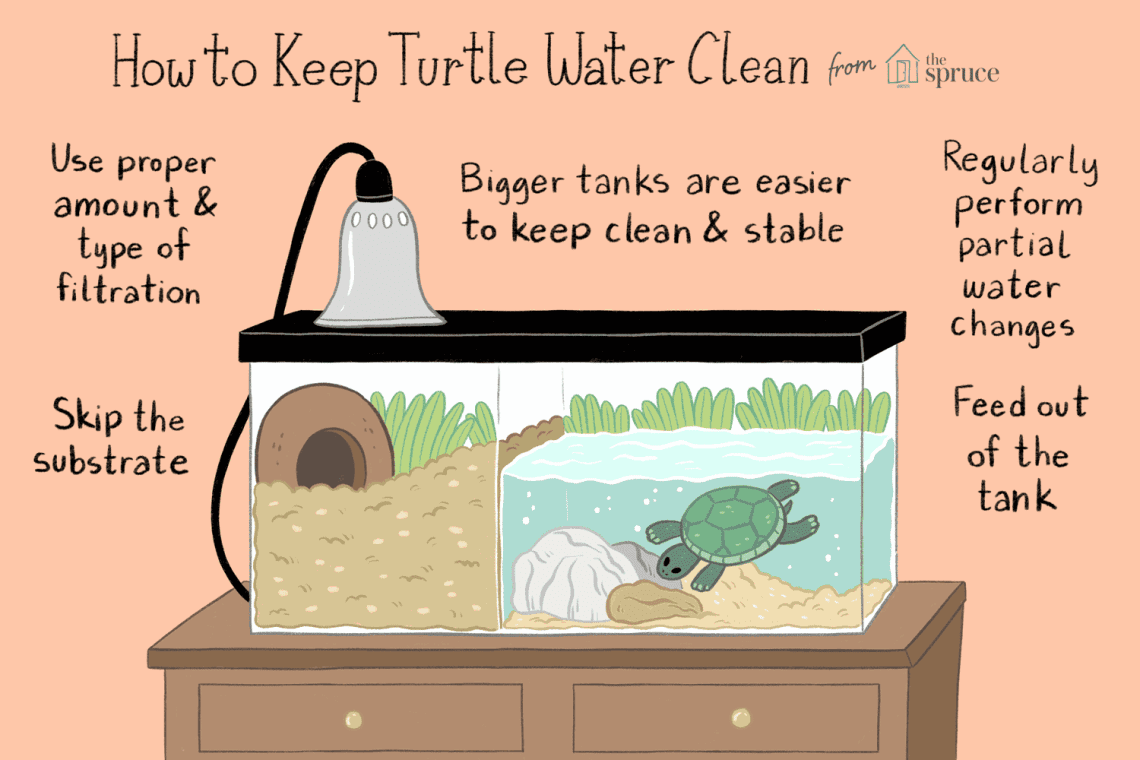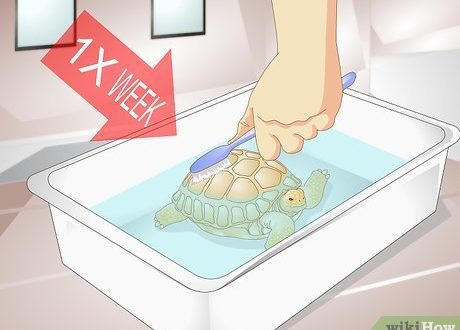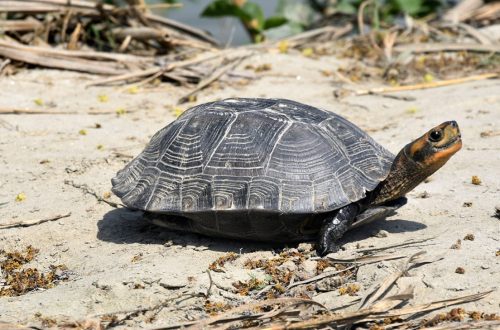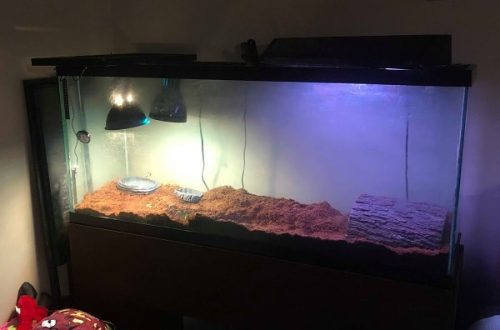
How to purify the water in the turtle aquarium?
Clean water in an aquaterrarium is a guarantee of aquatic turtle health and aesthetic pleasure for its owner. Dirty water and the unpleasant smell that can occur with improper care are the main reasons for the negative experience of the owners of these animals. Aquatic turtles spend most of their lives in the water element. We will tell you why a turtle has cloudy water in an aquarium and how to solve this problem.
What water suits turtles
Turtles, unlike fish, have lungs and breathe atmospheric air. The state of water for them is not a critical indicator. In nature, turtles often prefer swampy waters for living. However, at home, water transparency is an important parameter, especially for the owner. It is unlikely that anyone would want to have a swampy container with an unpleasant odor instead of a beautiful well-groomed aquaterrarium at home.
Water for turtles in an aquarium is prepared in much the same way as for fish. In advance, you need to draw water from the tap and let it stand for three to seven days in an open container. If it was not possible to prepare everything in advance, you can use water directly from the tap. Moderately chlorinated clean tap water will not harm your charges. The recommended temperature for a turtle tank is between 20 and 24 degrees. The same warm should be the water that we pour into the aquadome when replacing the water.
Water quality is affected by aquarium equipment. To keep a turtle aquarium clean, the best option is an external filter with a capacity of two to three times the volume of the reptile tank. Many turtle owners prefer to use both an external filter and an internal one. A heater and a thermometer will help you maintain the temperature of the water.
Don’t put the turtle tank on the window. The abundance of sunlight will only provoke the flowering of water, especially if there are underwater plants in the reptile’s dwelling. Turtles need ultraviolet rays, but window panes won’t let them through. But from the window the turtle can inflate – the pet draws to catch pneumonia.
Install a UV lamp above the aquarium. This is necessary in order for the turtle’s body to absorb calcium and produce vitamin D. UV rays also help to cleanse the contents of the aquarium from harmful bacteria.
If you need to put your hands in the aquarium to do something or fix something, first wash your hands with running water without soap. Skin fatty secretions may not have the best effect on the condition of the water in the aquaterrarium.
Pledge of purity
The water in the turtle tank needs to be changed as it gets dirty. On average, about 30% of the water volume should be changed once a week. Regular cleaning of the aquarium will keep it clean. To clean less often, initially choose a fairly spacious home for the turtle. For an adult with a body length of about 20 centimeters, an aquaterrarium with a volume of 100 to 120 liters is suitable. The larger the volume of water, the less water is polluted. Opting for an aquarium with a lid will keep the water out of dust. Don’t forget to make ventilation holes in the top of the lid: the turtle needs to breathe.
Let’s talk more about cleaning. This is not just replacing some of the water or adding new water to replace the evaporated one. Turtle aquarium cleaning should be done approximately once a month. This is not about a complete analysis of the filling of the aquarium with a thorough washing in parts. Such measures are necessary only in case of illness of the pet or other emergency. In the turtle aquaterrarium, as well as in the aquarium with fish, their own biobalance is established, the world of beneficial bacteria.
First, turn off and remove all equipment. We transplant the turtle into another container with warm water at a comfortable temperature. Drain some of the water. We carry out a siphon of soil. As a soil for the dwelling of an aquatic turtle, it is better to choose medium-sized flat pebbles so that the turtles do not accidentally swallow them along with food. Between the pebbles, particles of organic matter were probably tucked in – half-eaten food and pet waste products. We drain the water into a bucket during the siphon. In this water, wash the sponge of the external filter.
Use a melamine sponge or dishwashing sponge to clean the inside walls of the aquarium. We add new water prepared in advance to the aquaterrarium. Turn on the heater, filters. After a few minutes, we return the inhabitant to his tidied dwelling.
Cleaning should be done not only in the aquaterrarium, but also in the room where it stands. Ventilate the room, wipe the dust. Do not leave windows and doors open. Slots, holes in the walls and the floor are best repaired to protect the turtles from drafts.
Why is the water cloudy?
If the water in the aquarium is cloudy and smells unpleasant, there is no need to rush to conclusions and hastily change the water and rinse the soil. Remember biobalance. To deal with the problem, you need to understand the cause and evaluate the appearance of cloudiness.
The causes of cloudy water in an aquaterrarium are varied. Organic compounds can decompose at the bottom and pollute the water. Do not rule out that the filters you have installed do not cope with cleaning the aquarium. The solution may be to purchase a more powerful external filter and change the sponge in the internal filter twice a week. Long stay in the aquarium in the sun, lack of macronutrients can provoke the growth of algae.
Remember what changes you made to the aquarium recently. Turbidity of the water may be a reaction to the addition of drugs to the water or to the appearance of a new decoration made of not the highest quality material. Not a single element of decor is worth endangering the health of a pet.
If the aquarium water looks whitish and cloudy in the first couple of weeks after launch, this is normal. The same biobalance is established in the new environment. Be patient, do not change the water, this turbidity will disappear in the coming days.
Later, a partial replacement of about 30% of the water will help you restore the balance. To speed up this process, it will not be superfluous to run special bacteria into the aquaterrarium. In the absence of significant contaminants, you can simply scoop out some of the liquid and add the settled water.
Preventing cloudy water is easy. Immediately catch large, visible waste with a net. Never leave uneaten dry food floating in the aquarium. It contains fats, which almost certainly form a greasy film on the surface of the water. If you see a dirty or greasy stain on the surface of the water, land a napkin or a clean sheet of paper on the water surface. Remove carefully. The stain will remain on the paper.
Turtle is an active, mobile pet. If you decide to equip your ward with a sandy bottom aquadome, she will probably tear it open and destroy your finely thought-out original design. Powerful filtering will help here.
As with fish, overpopulation of a turtle tank will negatively impact water quality. If you have two adult turtles of medium size, they need more space. A container with a volume of 120 to 200 liters is suitable.
Most turtle enthusiasts have found an effective solution to the problem of decaying organic matter. They feed the turtle outside the aquarium. Young growing reptiles need to be fed once a day. For adults, one meal every two to three days is enough. If you put the turtle in a small container with warm water, it can eat there and quickly go to the toilet. After a lunch break, the turtle can be returned to the house and not worry that the organics will pollute the aquaterrarium.
If your city or area has especially hard water, over time, a white coating will become noticeable on the walls of the aqua-house and decorations. You can reduce the hardness with the help of special conditioners for aquarium water. Or you can use bottled non-mineral water for water changes.
Algae control
If the water in the turtle tank turns green, you are dealing with algae. This can happen due to excessive lighting, long daylight hours, sunlight on the aquarium, or rotting of dead leaves of underwater flora.
Mechanical cleaning of filamentous algae can be done with a net or even by hand. Green plaque can be removed from the walls with a scraper.
Be sure to reduce daylight hours in the aquaterrarium from 12 to six to eight hours. Hang the aquarium with a thick cloth. From lighting, you can leave the lamps for the turtle – ultraviolet and a 40 W incandescent lamp, under which the reptile is heated on the shore.
But a lot also depends on what kind of algae attacked your pet’s water. To combat blue-green algae, it is enough to add hydrogen peroxide (3%) to the water at a dosage of one milliliter per three liters of aquarium water.
To defeat blackbeard algae, you can add activated carbon for aquariums to an external filter and siphon the soil more often. Preventing water blooms will help isolate the aquarium from sunlight, use an aquarium ultraviolet sterilizer lamp, and change the water a little more often.
It is much more effective and safer to use special aquarium products to combat algae in aquariums. A consultant at the pet store will help you choose the right product.
Turbidity, blooming of water in a turtle aquarium is a signal about the processes taking place inside the aquaterrarium. It is important that you notice this, react in time and take care of the comfort and health of your turtle.
We wish that your aquarium always has clean water, and the turtles are healthy and happy!





